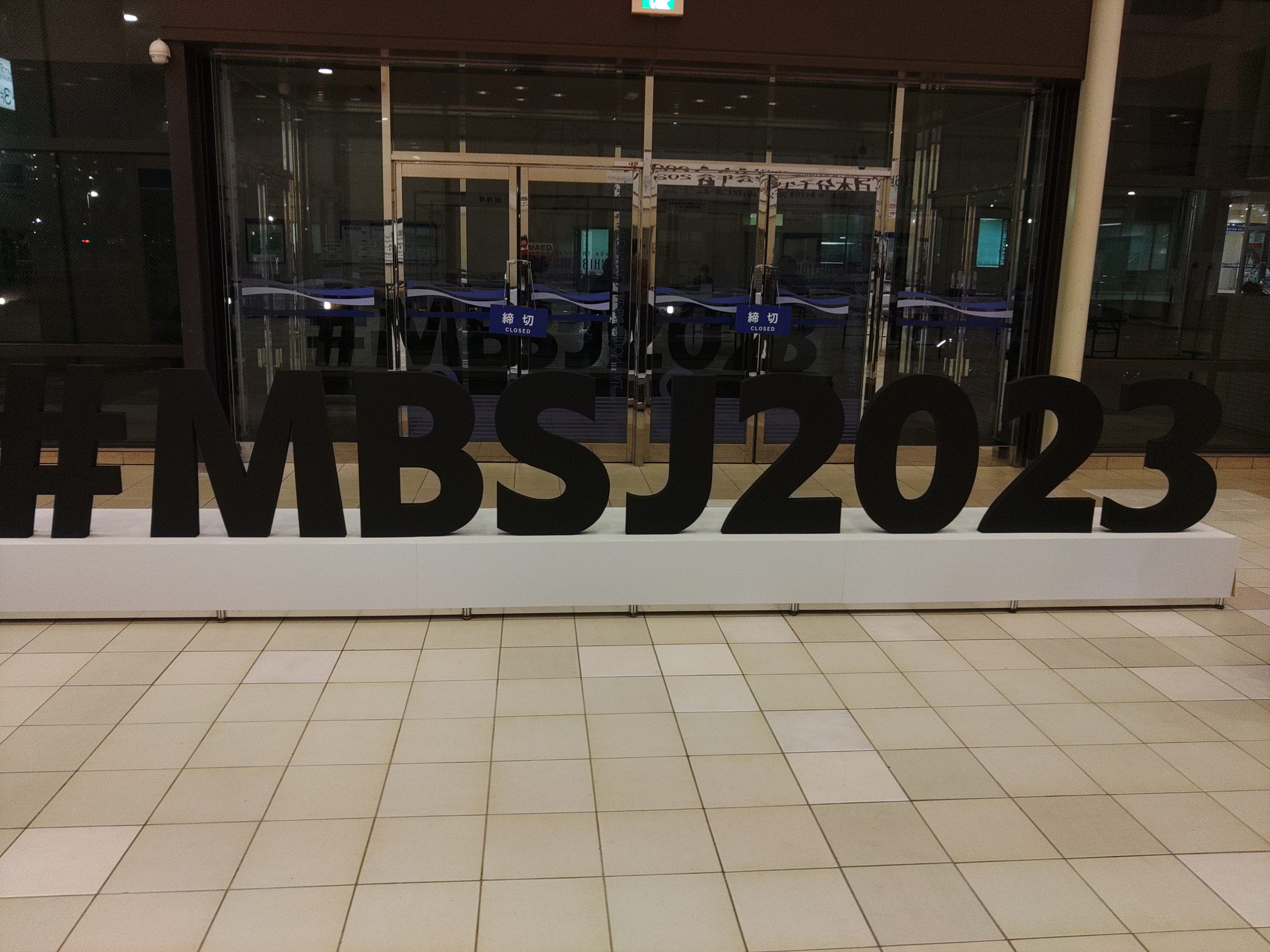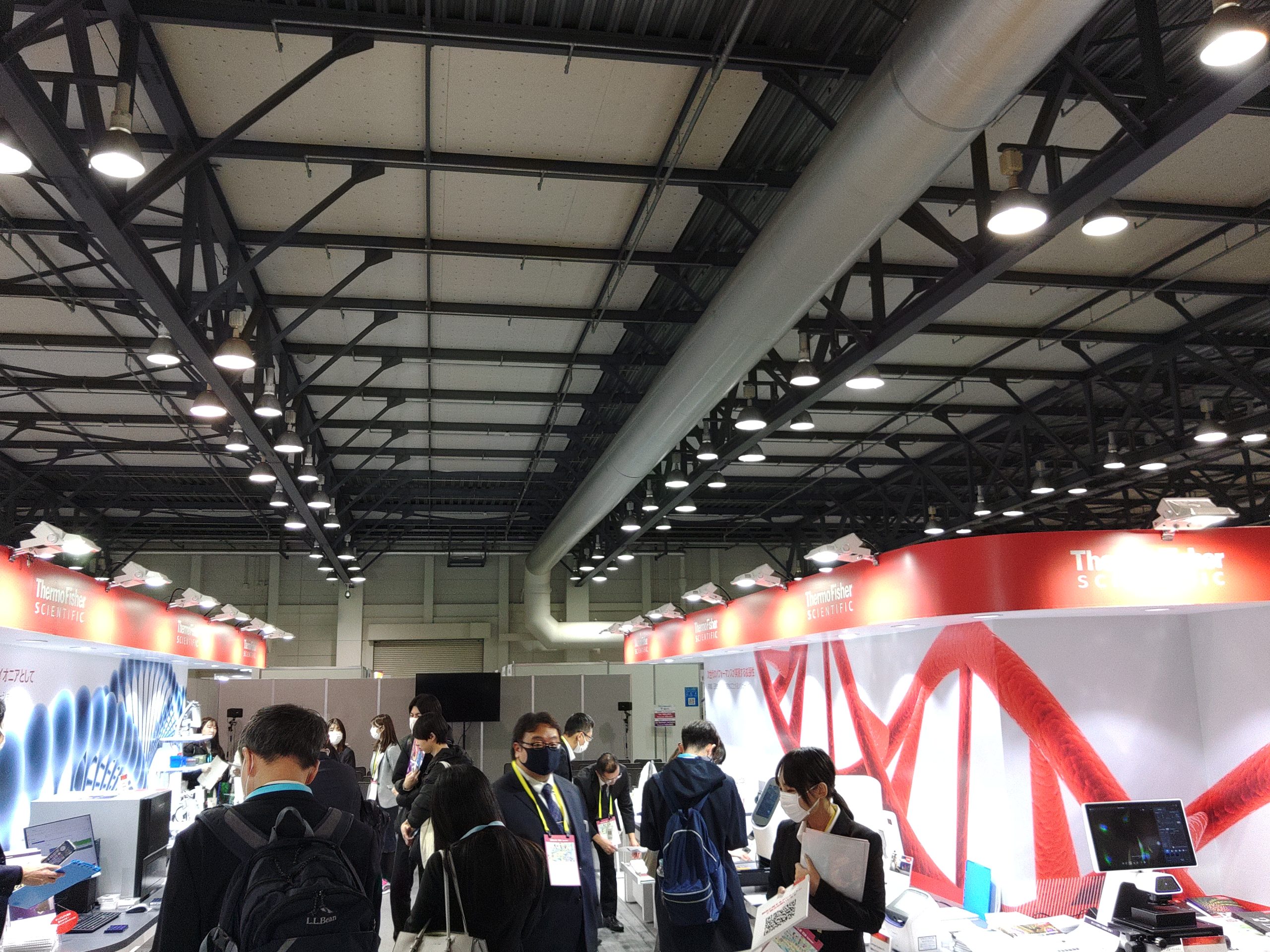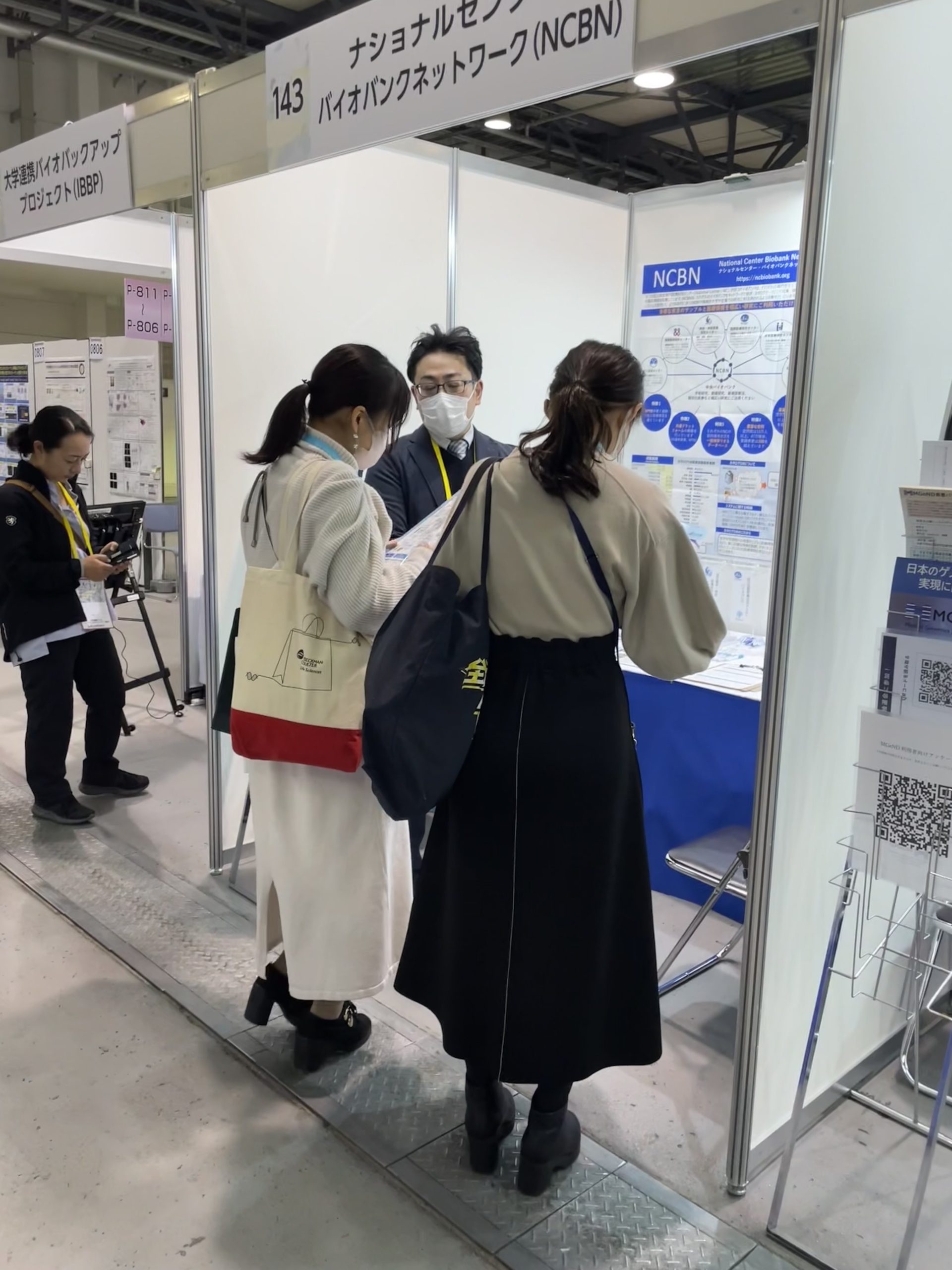2023.12.12
第46回日本分子生物学会(12月6日~8日)出展報告
Report on the 46th Annual Meeting of the Molecular Biology Society of Japan (December 6-8)
会期 :2023年12月6日(水)~8日(金)
会場 :国際展示場3号館(神戸市)
日本分子生物学会年会2023にてNCBNブースの展示を行いました。

NCBNブースは、国際展示場3号館のポスター展示場所のすぐ近くにあり、ランチョンセミナーやポスター発表の前後には人通りも多くなり、100名以上に来訪いただきました。
分子生物学会には何度か展示しておりますが、BBJや東北メガバンクに比べると認知度が低くまだまだ広報活動が必要であるという認識です。
学生さんにもたくさん来訪いただきました。NCBNのことを説明すると興味を持つ人が多く、中には自分の生体試料を提供したいとおっしゃってくれる方もいました。ありがたい話です。

約120名が来訪されました。パンフレット、ニュースレターは100部ほど持っていきましたが、全て配布することができました。
「遺伝子のデータベースなのか」「申請方法は大変なのか?申請したうち提供が許可されたものの割合はわかるか?提供されなかった場合の理由はどんなものがあるのか?」「なぜ特定のNCは分譲できないのか?」「分譲の際の価格が知りたい」「脳関連の試料はあるか」「小児のコントロール群データが欲しい」などの御意見・ご質問をいただきました。
遺伝子のデータベースなのかという質問については疾患のバイオバンクだと説明させていただきました。NCBNではサンプルとともに電子カルテのもつ背景情報や検査情報、投薬情報が提供できる旨を伝えると、皆様に関心いただけますので、やはり臨床情報は要望が高いという印象です。遺伝子解析の情報も加える事で更にNCBNの価値はあがるのではないかと考えました。
分譲の価格や申請方法、提供実績については、他の学会でもいただいた意見であるため、事例の紹介などを早期に対応できればと考えております。
特定の施設において分譲ができない件については複数名からご意見をいただきました。いただいた厳しい意見を元に、今後6NCが共通の分譲をできることを目標に検討を進めたいと考えております。

試料については血管や脳関連検体、培養細胞などの様々なお話をいただきました。その中で際立ったものは小児や新生児のコントロール群を集めることが難しいというお話です。NCBNにはコントロール群ゲノムのデータベースがあることの他、カタログデータベースでNCCHDの収集状況などを説明させていただくと、とても興味をもっていただきました。小児研究については、なかなか検体やコントロール情報が手に入らないため、研究が進みにくいのではないかという印象であり、NCCHDバイオバンクの存在は非常に重要と感じました。
最後に何度かブース出展を行っている日本分子生物学会ですが、NCBNはあまり知られておらず広報活動が今後も必要と考えております。
小児や新生児の健常者(コントロール)情報についての需要もあるのですが、NCCHDバイオバンク自体があまり知られていないように感じましたので、小児、新生児の研究を行う分野への広報活動の必要性と、NCCHDバイオバンクの重要性を認識しました。
また、前回の検査学会でもそうでしたが、目や血管など必要とする試料の幅が広く、すぐに対応できることではございませんがNCBNでも試料収集の幅を広げることができればさらにニーズが拾えると考えており、まだまだNCBNとして広げることができる道は広そうです。
Dates : December 6 (Wed.) – 8 (Fri.), 2023
Venue : International Exhibition Hall 3, Kobe, Japan
NCBN booth was exhibited at the Annual Meeting of the Molecular Biology Society of Japan 2023.
The NCBN booth was located near the poster exhibition area in the International Exhibition Hall No. 3 and was visited by more than 100 people before and after the luncheon seminars and poster presentations.
Although we have exhibited several times at the Molecular Biology Society of Japan, the NCBN was almost unknown to the public; some people said they knew about BBJ and Tohoku Megabank, but not the NCBN, and we recognize that we still need more publicity activities.
Those who knew about NCBN responded that they were thinking of using it but had not yet made a move, or that they were thinking of using it next time. We had many students visit us and when we explained about NCBN, many of them were interested, and some of them said they would like to donate their own biological samples. We are grateful for their interest.
About 120 people visited. We brought about 100 copies of brochures and newsletters, and we were able to distribute all of them. We asked about 40 of them to fill out a questionnaire, and 28 responded.
Some of the comments were: “Is it a gene database?” and “Is the application process difficult? Can you tell us the percentage of applications that were approved? What are some of the reasons why they were not provided?” Why can’t certain NCs be subdivided? What are the reasons?” We received questions such as, “I would like to know the price for subdivision,” “Do you have brain-related samples,” and “I would like to have pediatric control group data.”
As for the question of whether it is a gene database, we explained that it is a biobank of diseases. When we told them that we can provide test and medication information along with the samples, they seemed to be interested in the information, giving us the impression that clinical information is highly requested. We thought that the value of NCBN could be further enhanced by adding information on genetic analysis.
We would like to introduce case studies as soon as possible, as this is an opinion we have received at other conferences regarding the price, application methods, and results of NCBN sales.
We received several questions regarding the inability to sell lots at certain facilities. Based on the severe opinions we have received, we would like to proceed with the study with the goal of making common transfer available to all 6 NCs.
Regarding the samples, they talked about a variety of vascular and brain-related specimens, as well as cultured cells. What stood out among them was the opinion that it is difficult to obtain pediatric and neonatal control groups, and they were very interested when I explained that NCBN has control group genomes and also the status of NCCHD collection in the catalog database. We felt that the existence of the NCCHD biobank is very important because it is difficult to obtain specimens and control information for pediatric research, which may make it difficult to make progress in research.
Finally, although we have exhibited at the Molecular Biology Society of Japan booth several times, the NCBN is not well known and we believe that publicity activities will continue to be necessary.
There is a demand for information on healthy (control) children and newborns, but I felt that the NCCHD Biobank itself is not well known, so I felt that publicity activities for the field of pediatric and newborn research and, above all, the existence of the NCCHD Biobank itself are very important.
As was the case at the last conference, there is a wide range of samples needed, such as eyes and blood vessels, and although it is difficult to say, I thought that if NCBN could expand the range of sample collection, we would be able to pick up even more needs.
It seems that there is still a wide range of ways that NCBN can expand its business.
